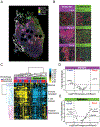Protein-based immune profiles of basal-like vs. luminal breast cancers
- PMID: 33623115
- PMCID: PMC8140991
- DOI: 10.1038/s41374-020-00506-0
Protein-based immune profiles of basal-like vs. luminal breast cancers
Abstract
Tumor-infiltrating lymphocytes play an important, but incompletely understood role in chemotherapy response and prognosis. In breast cancer, there appear to be distinct immune responses by subtype, but most studies have used limited numbers of protein markers or bulk sequencing of RNA to characterize immune response, in which spatial organization cannot be assessed. To identify immune phenotypes of Basal-like vs. Luminal breast cancer we used the GeoMx® (NanoString) platform to perform digital spatial profiling of immune-related proteins in tumor whole sections and tissue microarrays (TMA). Visualization of CD45, CD68, or pan-Cytokeratin by immunofluorescence was used to select regions of interest in formalin-fixed paraffin embedded tissue sections. Forty-four antibodies representing stromal markers and multiple immune cell types were applied to quantify the tumor microenvironment. In whole tumor slides, immune hot spots (CD45+) had increased expression of many immune markers, suggesting a diverse and robust immune response. In epithelium-enriched areas, immune signals were also detectable and varied by subtype, with regulatory T-cell (Treg) markers (CD4, CD25, and FOXP3) being higher in Basal-like vs. Luminal breast cancer. Extending these findings to TMAs with more patients (n = 75), we confirmed subtype-specific immune profiles, including enrichment of Treg markers in Basal-likes. This work demonstrated that immune responses can be detected in epithelium-rich tissue, and that TMAs are a viable approach for obtaining important immunoprofiling data. In addition, we found that immune marker expression is associated with breast cancer subtype, suggesting possible prognostic, or targetable differences.
Conflict of interest statement
CONFLICT OF INTEREST
Dr. Calhoun is a member of the Oncology Advisory Board for Luminex Corp
Figures


Similar articles
-
The composition of T cell infiltrates varies in primary invasive breast cancer of different molecular subtypes as well as according to tumor size and nodal status.Virchows Arch. 2019 Jul;475(1):13-23. doi: 10.1007/s00428-019-02568-y. Epub 2019 Apr 17. Virchows Arch. 2019. PMID: 31016433 Free PMC article.
-
The immune profile of small HER2-positive breast cancers: a secondary analysis from the APT trial.Ann Oncol. 2019 Apr 1;30(4):575-581. doi: 10.1093/annonc/mdz047. Ann Oncol. 2019. PMID: 30753274 Free PMC article. Clinical Trial.
-
Nodal status in luminal A invasive breast cancer: relationships with cytotoxic CD8 + and regulatory FOXP3 + cells tumor-associated infiltrate and other prognostic factors.Virchows Arch. 2021 Nov;479(5):871-882. doi: 10.1007/s00428-021-03126-1. Epub 2021 Jun 12. Virchows Arch. 2021. PMID: 34117905 Free PMC article.
-
Regulatory T lymphocyte infiltration in metastatic breast cancer-an independent prognostic factor that changes with tumor progression.Breast Cancer Res. 2021 Feb 18;23(1):27. doi: 10.1186/s13058-021-01403-0. Breast Cancer Res. 2021. PMID: 33602289 Free PMC article.
-
Immune infiltrates in the breast cancer microenvironment: detection, characterization and clinical implication.Breast Cancer. 2017 Jan;24(1):3-15. doi: 10.1007/s12282-016-0698-z. Epub 2016 May 2. Breast Cancer. 2017. PMID: 27138387 Review.
Cited by
-
Gene expression in metastatic breast cancer-patterns in primary tumors and metastatic tissue with prognostic potential.Front Mol Biosci. 2024 Feb 21;10:1343979. doi: 10.3389/fmolb.2023.1343979. eCollection 2023. Front Mol Biosci. 2024. PMID: 38449790 Free PMC article.
-
Best Practices for Spatial Profiling for Breast Cancer Research with the GeoMx® Digital Spatial Profiler.Cancers (Basel). 2021 Sep 4;13(17):4456. doi: 10.3390/cancers13174456. Cancers (Basel). 2021. PMID: 34503266 Free PMC article.
-
Multiplex Tissue Imaging: Spatial Revelations in the Tumor Microenvironment.Cancers (Basel). 2022 Jun 28;14(13):3170. doi: 10.3390/cancers14133170. Cancers (Basel). 2022. PMID: 35804939 Free PMC article. Review.
-
Progress in research on tumor microenvironment-based spatial omics technologies.Oncol Res. 2023 Sep 15;31(6):877-885. doi: 10.32604/or.2023.029494. eCollection 2023. Oncol Res. 2023. PMID: 37744276 Free PMC article. Review.
-
Quantitative analysis of breast cancer tissue composition and associations with tumor subtype.Hum Pathol. 2022 May;123:84-92. doi: 10.1016/j.humpath.2022.02.013. Epub 2022 Feb 23. Hum Pathol. 2022. PMID: 35218811 Free PMC article.
References
-
- Denkert C, von Minckwitz G, Darb-Esfahani S, Lederer B, Heppner BI, Weber KE, et al. Tumour-infiltrating lymphocytes and prognosis in different subtypes of breast cancer: a pooled analysis of 3771 patients treated with neoadjuvant therapy. Lancet Oncol 2018;19:40–50. - PubMed
-
- Luen SJ, Salgado R, Fox S, Savas P, Eng-Wong J, Clark E, et al. Tumour-infiltrating lymphocytes in advanced HER2-positive breast cancer treated with pertuzumab or placebo in addition to trastuzumab and docetaxel: a retrospective analysis of the CLEOPATRA study. Lancet Oncol 2017;18:52–62. - PMC - PubMed
-
- Loi S, Sirtaine N, Piette F, Salgado R, Viale G, Van Eenoo F, et al. Prognostic and Predictive Value of Tumor-Infiltrating Lymphocytes in a Phase III Randomized Adjuvant Breast Cancer Trial in Node-Positive Breast Cancer Comparing the Addition of Docetaxel to Doxorubicin With Doxorubicin-Based Chemotherapy: BIG 02-98. J Clin Oncol 2013;31:860–867. - PubMed
-
- Watanabe T, Hida AI, Inoue N, Imamura M, Fujimoto Y, Akazawa K, et al. Abundant tumor infiltrating lymphocytes after primary systemic chemotherapy predicts poor prognosis in estrogen receptor-positive/HER2-negative breast cancers. Breast Cancer Res Treat 2018;168:135–145. - PubMed
Publication types
MeSH terms
Substances
Grants and funding
LinkOut - more resources
Full Text Sources
Other Literature Sources
Medical
Research Materials
Miscellaneous

